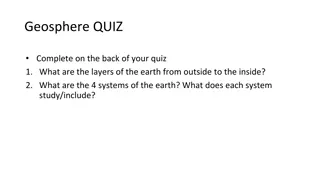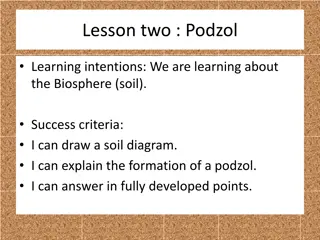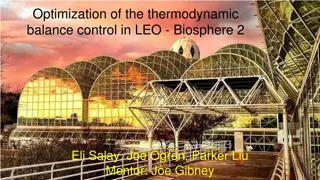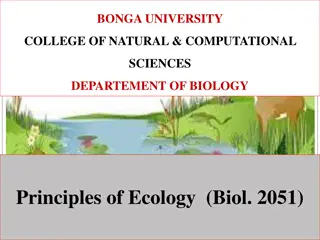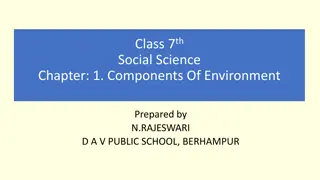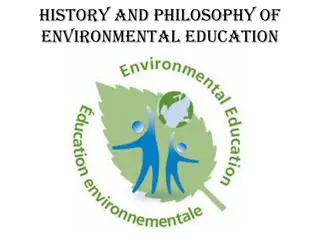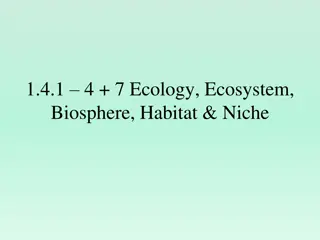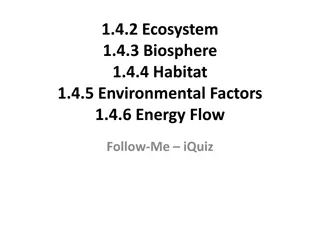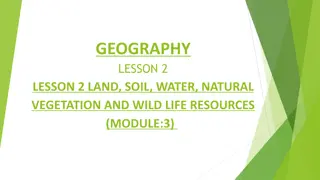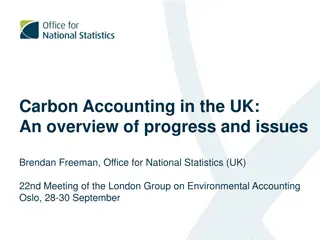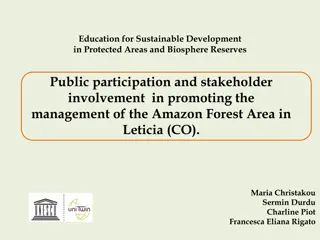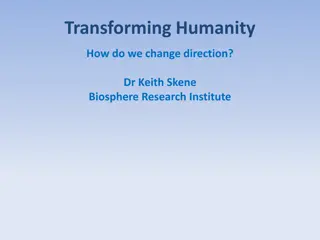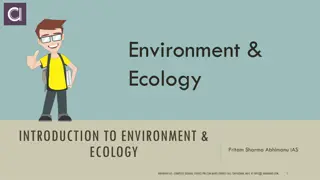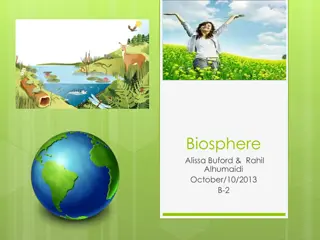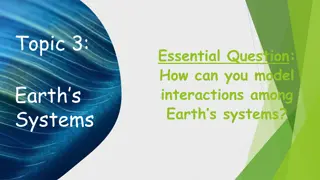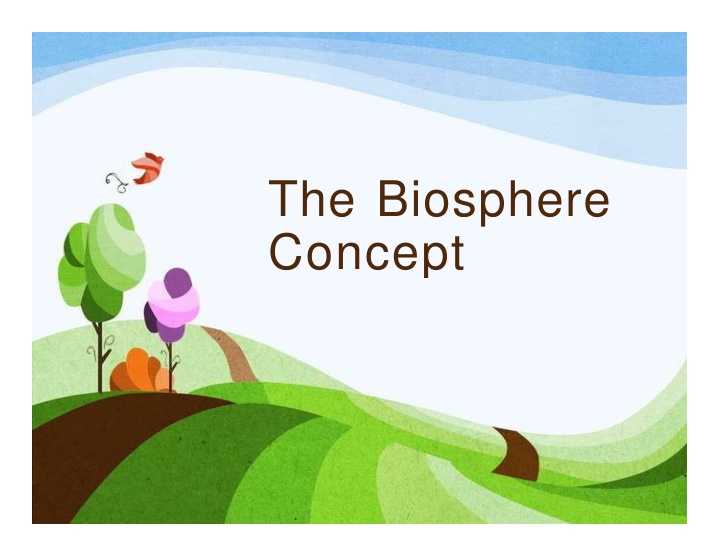
The Biosphere Concept
Explore the biosphere and ecology concepts through the levels of organization, from individual organisms to the entire Earth system. Learn about biodiversity, the interactions among organisms and their environment, and the subdivisions of the biosphere. Discover how the biosphere supports life and the importance of biodiversity in different ecosystems.
Download Presentation

Please find below an Image/Link to download the presentation.
The content on the website is provided AS IS for your information and personal use only. It may not be sold, licensed, or shared on other websites without obtaining consent from the author. If you encounter any issues during the download, it is possible that the publisher has removed the file from their server.
You are allowed to download the files provided on this website for personal or commercial use, subject to the condition that they are used lawfully. All files are the property of their respective owners.
The content on the website is provided AS IS for your information and personal use only. It may not be sold, licensed, or shared on other websites without obtaining consent from the author.
E N D
Presentation Transcript
The Biosphere Concept
What is Ecology? The Scientific study of the Interaction among organisms and between organisms and their environment Coined by Earnest Haeckel in 1866 Biosphere: Plants, life, water, land, air and part of the atmosphere
Levels of Organizations Study of the interactions between a particular organisations and its surroundings. Species Populations Community Ecosystem Biome Biosphere
Level of Organization Individual Group of organisms so similar that they can breed and produce fertile offspring Population Groups of individuals that belong to the same species living in the same area
Level of organization Community Groups of different populations within a defined area. Ecosystem Collection of organisms that live in a particular place with non-living: or physical environment.
Level of Organization Biome Group of Ecosystem that have the same climate and similar dominant communities Biosphere The Earth
Biosphere Biosphere is the global ecological system integrating all living being and their relationship Usually defined as the thin outer layer of the earth capable of supporting life.
Biosphere Subdivison Lithosphere rocky material of the earth s outer shell. Source of mineral elements required for life. Hydrosphere water on or near the earth s surface. Atmosphere the gaseous component of the biosphere. Atmospheric oxygen is produced by photosynthesis.
The biosphere includes many environments. - saltwater and freshwater environments Tidepool Estuary
Biodiversity is the variety of life. Biodiversity generally increases from the poles to the equator. Biodiversity is greater in areas with consistently warm temperatures. Biodiversity is greater closer to the equator.
The concept of the "biosphere," i.e., "the domain of life," was introduced in biology by Lamarck (1744-1829) in Paris at the beginning of the nineteenth century, and in geology by Edward Suess (1831-1914) in Vienna at the end of that century. Vernadsky greatly expanded and developed the concept of the biosphere. tfe imbued that very word first scientist Jean- tfdoelg y , o o g r y to denote the totality of our planet s living organisms with much deeper meaning. proposed by the French in 1802, Baptiste Lamarck in his book Now definition as the sum total of sedimentary rocks created by organisms, the sense in which it had been used in the late 19th century by the Austrian geologist Eduard Suess in T h e O rg n i i o f t h eA p, s l and the German Walther, well-known for his works on lithology. the term biosphere went far beyond its simple geologist Johannes
Physical and chemical factors influence life in thebiosphere The most important abiotic factors that determine the biosphere s structure and dynamics include the energy source, usually solar energy, temperature, abundance and type of water, nutrients, other aquatic factors such as availability of oxygen, and other terrestrial factors including wind and fire.
Vernadsky discusses the biosphere as an interface between the physical planet and its cosmic environment. The emphasis is on the radiations arriving From space, their transformation by the living biosphere, and the role of the biosphere in determining the complex chemical composition of the Earth's crust. 1. Living matter is not created from inert matter. 2. There are no lifeless geological eras. 3. Living matter of all eras has been similar to contemporary living matter. 4. Throughout all eras, there have been no sharp changes in the influence of living matter on its surroundings, and in all, the average chemical compositions of living matter and crust have been similar to ours. 5. There have been no great changes in the quantity of living matter. 6. All the energy produced by living matter derive from the Sun. 7. tfe even states one of the key ideas that appear later in Lovelock's Gaia theory: the biosphere acts as a thermostat
Vernadsky teaches us that life, including human life, using visible light energy from our star the Sun, has transformed our planet over the eons. tfe illuminates the difference between an inanimate, mineralogical view of Earth's history, and an endlessly dynamic picture of Earth as the domain and product of life, to a degree not yet well understood. No prospect of life's cessation looms on any horizon. What Charles Darwin did for all life through time, Vernadsky did for all life through space. Just as we are all connected in time through evolution to common ancestors, so we are all through the atmosphere, lithosphere, hydrosphere, and these days even the ionosphere connected in space
Vernadskys View Life occurs on a spherical planet. Vernadsky is the first person in history to come [to] grips with the real implications of the fact that Earth is a self-contained sphere. Life makes geology. Life is not merely ageological force, it is thegeological force. Virtually all geological features at Earth's surface are bio-influenced, and are thus part of Vernadsky's biosphere. The planetary influence of living matter becomes more extensive with time. The number and rate of chemical elements transformed and the spectrum of chemical reactions engendered by living matter are increasing, so that more parts of Earth are incorporated into the biosphere.
Vernadsky identified the boundaries of the biosphere as well as its composition, energetics, and dynamics. tfe included in the biosphere the upper part of the lithosphere to a depth of 2 - 3 km, which contains living bacteria, the hydrosphere, and the lower part of the atmosphere. Within the biosphere he distinguished two component types of matter: minerals, which he termed inert, and living matter. The morphology of inert matter (its chemical composition and physical state) is preserved unchanged in the course of geological time, while living matter, both in totality and in its individual forms, undergoes continual change in the process of the biosphere s evolution as an integrated system.
Vernadsky component of the biosphere, to be the carrier of free energy in the processes, viewing certain forms of homogeneous living matter that have remained unchanged for billions of years (such as some species of R d o a i a r l i a that have been unchanged since the Algonkian Era, or the genus L n u a , l g i unchanged since the Cambrian Era) as exceptions. considered living matter, the active geochemical biosphere s At the same time, he rejected the existence of any special zones between matter, advancing the that there are no transitions between living and inert natural bodies of the biosphere living empirical and non-living generalization
Vernadsky viewed the biosphere and the conditions under which life emerged inseparable component of a certain structure of the Earth s crust and its degree of organization. on our planet as an tfe geochemistry, empirical material accumulated by these sciences. based this and conception the on geology amount and tremendous of Geology scientific question of the origin of the biosphere, while geochemistry provided a reliable determination of the conditions necessary for the creation of the biosphere and the emergence of life. had made it possible to formulate the In his judgment, the task of geochemistry was the study of the history of the chemical elements within the bounds of our planet, and this new branch of natural science was in Vernadsky s work. fact established through
Vernadsky thought that the continuous migration of atoms in the Earth s crustal layer was biogenic to a significant degree, i.e., that geochemical energy of living matter (the energy of life), connected first and foremost with the processes of alimentation and respiration of living organisms. it was caused by the tfe matter changes the structure of inert matter, acting upon chemical compounds states, and inducing a stable state organic molecules under conditions of the biosphere. came to the surprising conclusion that living and even upon atomic of carbon in the thermodynamic Vernadsky thought that living organisms should be characterized quantitatively in the same way as other bodies, according to their atomic composition, mass, and energy, and that the mass of living matter and its average chemical composition in the biosphere are not changed or disrupted by the process of evolution.
Solar and chemical energy serve as the original source of the energy of life. The absorption photoautotrophs the living matter that uniquely transforms solar energy into chemical throughout the planet si one functions of living matter in the biosphere. of solar energy by energy of and distributes important it the most And this is the basic energy source for exogenous geochemical and geological processes. In other words, living transforming solar radiation, draws inorganic material into continuous circulation. matter, This idea is central to the concept of biogeochemistry, which Vernadsky introduced. In it he included the functions of the exchange of matter respiration, the body mass of organisms, their movements and the work they perform, and even grander of human communities. alimentation, creation of undertakings on the scale the free oxygen on our planet is created almost entirely by the geochemical energy of life by the photochemical processes of the plant world.
Vernadsky advanced three propositions, asserting that the existence of the biosphere and the appearance of living matter were inseparable. tfe believed that the biosphere was not an accidental formation, but rather a distinctive lawful mechanism, whose individual parts are connected and mutually conditioned, and which has the property of being organized. Finally, he held that the basic features of the structure and mechanism of the interactions on which the biosphere based were stable and constant, and that it had been a stable system in dynamic equilibrium over the billions of years since its origin, in the Archean Eon, similar to the stability and immutability of the configuration of the Solar System is Closed interactions are an important component, are a condition for the stability of the biosphere and, at the same time, represent the basis of life as a biospheric process. biotic cycles, of which nutrient (trophic)
Such processes as the growth of the biomass of organisms, the assimilation of matter, energy exchange, the differentiation/migration of the chemical elements, and the synthesis and breakdown of organic compounds at all stages of the trophic cycle in biocenoses, are all connected with these biotic cycles. The bacteria and plants of the early biosphere (the autotrophs) utilized carbon from atmospheric carbon dioxide and possessed no mechanism for nitrogen fixation or photosynthesis, nor did they have fermentation systems, which would have provided energy through the hydrolytic decomposition of their internal structures. These processes arose later in the course of evolution, and our modern animal world (heterotrophs), with its extraordinarily complex organization, consumes a wide array of organic and inorganic materials.
tfe viewed the biogeochemical functions of the biosphere, which provide the basis for life, as immutable, having existed continuously throughout geological time. f unctions: gas exchange involving N2-O2-CO2-Ctf4- tf2-Ntf3-tf2S, which is effected by all organisms; the oxygen function performed by photosynthetic plants; the oxidation and reduction functions, supplied primarily by bacteria, including autotrophic bacteria; the calcium function, carried out by algae, moss, and marine organisms, as well as by bacteria; and the concentration function, performed by unicellular and multi-cellular organisms. Vernadsky included among these biogeochemical Biogeochemical functions are also responsible for the breakdown of organic compounds by bacteria and fungi, and for metabolism and respiration.
Vernadsky considered the stratified part of the Earths crust (the Earth s sedimentary envelope) to be the remnant of earlier biospheres, and thought that even the granite-gneiss layer had been formed as a result of the metamorphism and remelting of rocks formed earlier under the influence of living matter. In other words, only basalts and the other main magmatic rocks are abyssal, unconnected to the biosphere is a global ecosystem in which connections among the gaseous, liquid, regulated by living matter, properties result from the activity of these envelopes. their formation Thus, being biosphere. Vernadsky s and and the biosphere s basic solid envelopes are Life, therefore, is Earth s planetary constant, which is closely bound up with the structure and the function of these envelopes. Life is not . occurrence on the surface of the Earth, he said. Never in all geological time have there been azoic geological epochs. . . an external random
Vernadsky has emphasized the existance of Life stability field- conditions which life withstands without ceasing its function i.e., conditions under which an organism suffers, but survives Life existence field conditions under which an organism can produce progeny i.e. increase the living mass. Earth limit the development of life and determine the boundaries of biosphere First condition is sufficient amount of CO2gas and oxygen in the biosphere. Second-Sufficient amount of water(liquid) which ensures enzymatic processes Third- Favourable thermal condition which preclude both too high temperature (Coagulation of temperature) and too low temperature (stop the work of enzyme)
Characteristic features of biosphere as dynamic system is its nonequlibrium In 1935 Erwin Bauer said that living systems are never in equilibrium. At the expense of the free energy they constantly perform work to avoid the equilibrium required by the laws of physics and chemistry under existing external conditions. It is called the principle of Bauer.. This principle is valid for the biopshere as a whole. The gaseous composition of the atmosphere and the salt composition of ocean are not in equlibrium.
Record holders in survival are procaryotic organisms- Bacteria and cyanobacteria Fourth condition is the presence of subsistence wage of the elements of a mineral diet- a factor which to a consirable extent limits life within large areas of oceans Fifth is the hypersalinity of the aqueous medium, which when approximately ten times higher than the concentration of salt water limits life.
Biosphere as cybernetic system Biosphere possess the properties of self regulation. Biotic components of the biosphere has played a very important role in achieving self regulation. Atmospheric radiation created a chemical evolution leading to the formation of complex organic molecules such as amino acids which formed the building block of primitive life. Thus first living organism were yeast like anaerobes that obtained their energy for respiration through fermentation. Slowly evolved and the composition of the gaseous envelope of our planet changed. This showed that life regulated the atmosphere of the planet. photosynthetic organisms
Second example of self regulation is the world ocean Every year river introduce 1.5 million tons of calcium carbonate into the ocean, but the salt composition of oceanic water remain substantially unchanged. Why? Because organisms use these calcium carbonates for building their skeleton and after their death these carbonates go down to oceanic floor. Some of these later came up as limestone hill by geological upheavals. Because of this cybernetic nature biosphere is extremely stable and resilient to external shock.
One reason for this stability and remarkable external resilience is the high diversity of the biosphere. According to the diversity law of Ashby a cybernetic system possess stability for blocking external and internal disturbances only when it has sufficient internal diversity. The earth is characterized by considerable diversity of natural conditions. This is determined by Its spherical shape, revolution around the sun and rotation around its own axis. These provide latitudinal and seasonal changes in the intensity of solar energy input and considerable diversity of natural conditions But the main created by living organisms diversit y of eart hs biosphere is
This stability is determined by exclusive diversity, unlimited number of living organisms, interchangeability of the ecosystem constituting the biosphere, by the vital resilience and activity of individuals . Thus the earths biosphere is a self regulated cybernetic system with ever increasing noise immunity possessing the properties of homeostasis which is determined by the activity of living matter( tf. T.Odum, 1983). The heterogeneity of the structure of the biosphere is determined by the presence of regions in it which differ in their biogeochemical specialisation or biogeochemical provinces. These provinces are areas on the surface of earth differing from the adjacent areas in the concentration of chemical elements and as a result causing different biological reactions of local flora and fauna.
The vertical width of the biosphere in the ocean covers the entire depth of oceanic waters and includes the bottom film of life which varies markedly in thickness. The biosphere on continents comprises a thin superficial layer and a thick underground layer. Fig. Distribution of living organisms in the earth s biosphere
Vassoyevichs View Vernadsky had not defined what he implied by the surrounding of biosphere A contemporary explanation is given by Vassoyevich. tfe mentioned about Megabiosphere- a multilayered envelope of the earth, formed as a result of the activity of living matter-upper boundary-limit to which the biogenic atmosphere extends Lower boundary- envelope of earth not subject to the influence of life.
Megobiosphere includes The Apobiosphere- the upper portion of Earth s atmosphere which is beyond the boundary to which abiotic life forms extend The parabiosphere (tfutchinson)-a zone overlaying the biosphere---life stability field Enbiosphere (tfutchinson)- Metabiosphere - which corresponds to the area of bygone biosphere-envelope of the earth that had at any time been subject to the influence of life.
Significance of the concept of Biosphere Paramount importance of living matter - large and small, plants, microbes and animals. Interconnectedness of abiotic and biotic factors Importance of conservation and sustainable development The development of biosphere is determined by the constant influx of energy from space. Characterised by the presence of liquid water and extensive low temperature reactions which proceed in the aqueous medium and are to a considerable degree regulated by the action of enzymes.
Biosphere produces gaseous envelope towards its outer edge and an envelope of sedimentary rock towards the interior of the planet. Man occupies a specific place in the biosphere. Man came to realize the overall interconnectedness of natural phenomenon and of his role in it. Vernadsky called the biosphere controlled by the mind of man, the noosphere. Teilhard de Chardin defined the noosphere as a new canopy , a thinking stratum.

